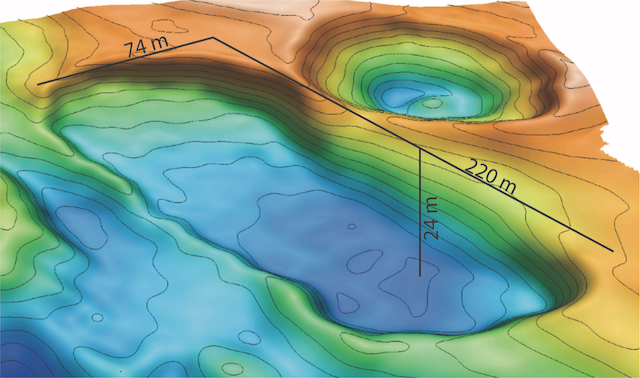I’m afraid I have something of a confession to make. When learning about the dangers posed by thawing permafrost, it never occurred to me that there might be such a thing as underwater permafrost. Turns out there is, and that’s melting too.
Across the Arctic, numerous peer-reviewed studies show that thawing permafrost creates unstable land which negatively impacts important infrastructure and impacts Indigenous communities. Now, a new study from MBARI researchers and their collaborators published in the Proceedings of the National Academy of Sciences finds dramatic changes offshore and is the first to document how the thawing of permafrost submerged underwater at the edge of the Arctic Ocean is affecting the seafloor.
About one quarter of the land in the Northern Hemisphere is permafrost or frozen ground. At the end of the last ice age (12,000 years ago) melting glaciers and sea level rise submerged large swaths of permafrost. Until just recently, this submerged permafrost had been largely inaccessible to researchers. But now, thanks to technological advancements, including MBARI’s autonomous mapping robots, scientists are able to conduct detailed surveys and assess changes in the seafloor.
High-resolution bathymetric surveys in the Canadian Beaufort Sea have revealed changes in the seabed from 2010 to 2019. Using autonomous mapping robots, scientists documented multiple large sinkhole-like depressions—the largest the size of an entire city block of six-story buildings—had developed in less than a decade.
“We know that big changes are happening across the Arctic landscape, but this is the first time we’ve been able to deploy technology to see that changes are happening offshore too,” said Charlie Paull, a geologist at MBARI who led the study with Scott Dallimore from the Geological Survey of Canada, Natural Resources Canada, and an international team of researchers. “While the underwater sinkholes we have discovered are the result of longer-term, glacial-interglacial climate cycles, we know the Arctic is warming faster than any region on Earth. As climate change continues to reshape the Arctic, it’s critical that we also understand changes in the submerged permafrost offshore.”

Repeated surveys with MBARI’s mapping AUVs revealed dramatic, and rapid, changes to seafloor bathymetry from the Arctic shelf edge in the Canadian Beaufort Sea. This massive sinkhole developed in just nine years. Image: Eve Lundsten © 2022 MBARI
It seems there’s something of a thawing and re-freezing process going on, which could account for the creation of sinkholes without any real methane release, but that doesn’t mean that couldn’t change if frozen organic matter is thawed long enough to start rotting. I’m honestly more worried about the stability of methane clathrates. If it turns out this process is widespread on the seafloor in the Arctic, or if it’s becoming more so, then that could cause a lot of problems. As ever with this stuff, we probably won’t know if we’ve crossed a deadly threshold until it’s far too late to do anything about it. It would be better to be proactive than reactive.
On the plus side, maybe it’s just Kroll waking up.
If you like the content of this blog, please share it around. If you like the blog and you have the means, please consider joining my lovely patrons in paying for the work that goes into this. Due to my immigration status, I’m currently prohibited from conventional wage labor, so for the next couple years at least this is going to be my only source of income. You can sign up for as little as $1 per month (though more is obviously welcome), to help us make ends meet – every little bit counts!

Yup! here’s hoping. Remember watching that as a kid & loved that one. Still the best incarnation of the Doctor I’d say – though admittedly nostalgia biased.
Cheers. Shared.
Tamgential but I guess everyone’s already aware of the National Snow & Ice Data Centre site :
http://nsidc.org/arcticseaicenews/
Which tracks Arctic, Antarctican and Greenland sea ice & ice sheets – at least on their surface levels yeah?
That’s a disappointment.
When I read the title of the post, I was hoping it was Cthulu.
I think Cthulhu is further south (and Kroll is on an exoplanet moon).
There’s a scene in The Power of Kroll with some folks in a methane harvesting plant are monitoring activity on the bottom of the swamp, and it looks somewhat similar to the image above